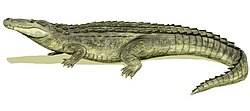Description
The hypodigm of Acresuchus consists of the holotype, UFAC-2507, a nearly complete skull, and several referred specimens, most found in Niteroi, located in the Solimões Formation in Acre. Acresuchus takes its name from the state it was found in (Acre), while the species name pachytemporalis refers to the extreme thickening of the squamosal bones in the holotype. [2] Another specimen, MCNUSB-PB-02FU-RS43, a skull fragment, was found in the middle member of the Urumaco Formation in Venezuela. [3]
According to the describing authors, Acresuchus is a "caimanine with a medium-sized body, teeth with smooth (non-serrated) carinae, orbits large in comparison with other caimanines, having roughly straight margins that are larger than the infratemporal fenestrae, circular external naris, posterior margin of the skull table transversely straight to slightly concave, posterolateral margin of squamosal upturned throughout the entire dorsal lateral margin with a dorsoventral expansion in the posterior portion of the eminence," with the last trait being a unique trait within the subfamily Caimaninae. [2]
The holotype of Acresuchus has an estimated skull length of 51.5 cm (20.3 in), smaller than all three species of Purussaurus, which suggests that Acresuchus may have represented a transitional form between the traditional caiman body plan and that of Purussaurus. Acresuchus lacked an enlarged external nostril, which in Purussaurus is hypothesized to reduce stress when biting, thus creating a more powerful bite. However, Acresuchus has small depressions in the posterior portions of the maxillae, similar to the deep excavations found in Purussaurus. These depressions may increase with body size in the Acresuchus-Purussaurus clade. [2]
Acresuchus shares traits with Purussaurus that may have been adaptations to large body size, such as large supratemporal fenestrae. These provided quicker capture of prey and better thermoregulation. [2]
A 2022 study estimated the body size of Acresuchus,Purussaurus, and another extinct caimanine, Mourasuchus using skull width and the dorsocranial length of the skull, determining that dorsocranial length is affected by changes in the skull throughout growth. Therefore, the authors used their estimates derived from skull width, estimating the length and mass of Acresuchus as 3.744 metres (12.28 ft) and 260.3 kilograms (574 lb), respectively, using ordinary least squares regression, while the estimates made utilizing a phylogenetic least squares regression recovered estimates of 3.401 metres (11.16 ft) and 225.6 kilograms (497 lb). The authors of the study acknowledged the lower results of the phylogenetic approach, stating that it may be due to a weaker correlation between skull width and body size compared to OLS. [4]
This page is based on this
Wikipedia article Text is available under the
CC BY-SA 4.0 license; additional terms may apply.
Images, videos and audio are available under their respective licenses.



